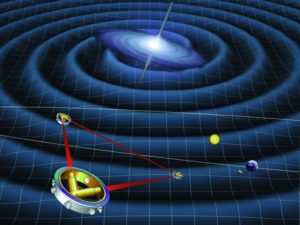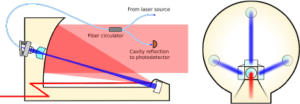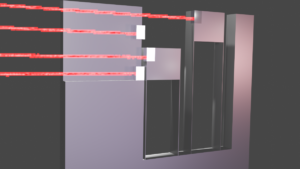Optical Truss Interferometer

Artist rendering of the LISA Space Telescope
One daunting challenge in gravitational wave interferometry is dealing with local noise sources and being able to distinguish gravitational wave sources from the noisy environment. For this reason, Earth-based gravitational wave detectors, such as LIGO, are mainly restricted to the audio frequency band where transient events are observed such as the merger event of a binary black hole system. A key advantage of LISA, a space-based detector, is the ability to measure gravitational waves in a bandwidth from 0.1 mHz to 1 Hz. Detection in this bandwidth has not yet been achieved for gravitational waves and would introduce valuable knowledge of the universe

Shown above is a conceptual schematic portraying how the truss cavities will be mounted onto the telescopes. On the left is a side view, where the OTC input stage can be seen attached around the primary (leftmost) mirror of the telescope, and the back cavity mirror is attached on the other end of the telescope around the secondary mirror. On the right is a head-on view, where the three truss cavities are shown to be mounted around the telescope mirrors. The use of three truss cavities is key, as this allows for the measurement of not only lengthwise variations in the telescope, but more importantly, this allows for the measurement of differential length changes at three separate locations around the telescope mirrors. These measurements will give insight into the torsional stability of the telescope, which is the main goal of the OTI project.
Using a PDH-like frequency locking technique, variations in the OTC cavity lengths will change the frequency of the locked laser light. Thus, monitoring the frequency variations in the laser light will in effect monitor length variations in the telescope structure. The frequency variations will be monitored using heterodyne detection by measuring a beat frequency between the laser light from each OTC and a laser that is locked to a stable reference cavity. Current work is focused on the development of the compact input stage for the OTCs.
Researchers Involved:
Compact Sensors for LIGO

A rendering of the sensor being developed for use in LIGO. There are two fused silica resonators, each with a different resonance in order to increase the bandwidth of the sensor. The acceleration of each resonator is measured by observing the phase difference between two beams of light: one that is reflected off a mirror on the test mass and one that is reflected off a mirror on the frame of the sensor.
The gravimeters employed by LIGO tend to suffer from one or more drawbacks, including being large, expensive, and incompatible with vacuum or cryogenic temperatures. One of our projects in LASSO is to develop a gravimeter that does not have these drawbacks while maintaining a competitive acceleration sensitivity. As shown in Figure 1, the sensor we envision creating for use in LIGO uses two optomechanical resonators with different frequencies. Such resonators are projected tot have acceleration noise floors that are competitive with the accelerometers already used by LIGO and using two different resonators increases the bandwidth of the sensor to meet LIGO’s requirements.
Researchers Involved:
